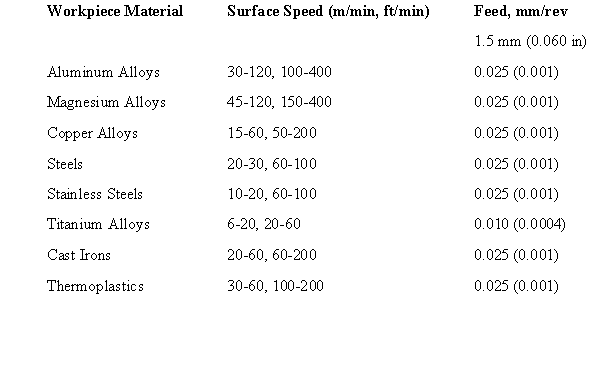Drills and drilling
Twist drill
The twist drill bit is the type produced in largest quantity today. It drills holes in metal, plastic, and wood.
The twist drill bit was invented by Steven A. Morse of East Bridgewater, Massachusetts in 1861. He received U.S. Patent 38,119 for his invention on April 7, 1863. The original method of manufacture was to cut two grooves in opposite sides of a round bar, then to twist the bar to produce the helical flutes. This gave the tool its name. Nowadays, the drill bit is usually made by rotating the bar while moving it past a grinding wheel to cut the flutes in the same manner as cutting helical gears.
Tools recognizable as twist drill bits are currently produced in diameters covering a range from 0.05 mm (0.002") to 100 mm (4"). Lengths up to about 1000 mm (39") are available for use in powered hand tools.
The geometry and sharpening of the cutting edges is crucial to the performance of the bit. Users often throw away small bits that become blunt, and replace them with new bits, because they are inexpensive and sharpening them well is difficult. For larger bits, special grinding jigs are available. A special tool grinder is available for sharpening or reshaping cutting surfaces on twist drills to optimize the drill for a particular material.
Manufacturers can produce special versions of the twist drill bit, varying the geometry and the materials used, to suit particular machinery and particular materials to be cut. Twist drill bits are available in the widest choice of tooling materials. However, even for industrial users, most holes are still drilled with a conventional bit of high speed steel.
The most common twist drill (the one sold in general hardware stores) has a point angle of 118 degrees. This is a suitable angle for a wide array of tasks, and will not cause the uninitiated operator undue stress by wandering or digging in. A more aggressive (sharper) angle, such as 90 degrees, is suited for very soft plastics and other materials. The bit will generally be self-starting and cut very quickly. A shallower angle, such as 150 degrees, is suited for drilling steels and other tougher materials. This style bit requires a starter hole, but will not bind or suffer premature wear when a proper feed rate is used.
Drills with no point angle are used in situations where a blind, flat-bottomed hole is required. These drills are very sensitive to changes in lip angle, and even a slight change can result in an inappropriately fast cutting drill bit that will suffer premature wear.
Drill bit geometry has several aspects
• The spiral, or rate of twist in the drill, controls the rate of chip removal in a drill. A fast spiral drill is used in high feed rate applications under low spindle speeds, where removal of a large volume of swarf is required. Low spiral drills are used in cutting applications where high cutting speeds are traditionally used, and where the material has a tendency to gall on the drill or otherwise clog the hole, such as aluminum or copper.
• The point angle is determined by the material the drill will be operating in. Harder materials require a larger point angle, and softer materials require a sharper angle.
The correct point angle for the hardness of the material controls wandering, chatter, hole shape, wear rate, and other characteristics.
Most drills for consumer use have straight shanks. For heavy duty drilling in industry, drills with tapered shanks are sometimes used.
Drilling as a Manufacturing Process

Hole making is one of the most important machining operations in the manufacturing process. Holes serve a variety of functions including but not limited to: fasteners for assembly, weight reduction, ventilation, access to other parts, or simply for aesthetics.
On most workpieces it is vitally important that the hole be drilled precisely in reference to the x, y, z-axes. When possible drilled holes should be located perpendicular to the workpiece surface. This is due to the large length-to-diameter ratio which causes the drill bit to be easily deflected which can cause the hole to be misplaced, or the drill bit to break or fatigue. Òhere are many methods for hole making.
Because drilling can often be such a critical process there are a number of considerations that should be taken in order to ensure the most accurate drill hole possible.
As mentioned before the hole and drill motion should be perpendicular to the surface of the workpiece to reduce the tendency to fatigue or break the drill bit. This also helps to reduce 'walking' of the drill bit over the workpiece surface.
• Create through holes instead of blind holes when possible.
• If a blind hole must be drilled and tapped, it should be drilled deeper than the tapped depth.
• Holes that need to be reamed must also be initially drilled deeper than the reamed hole depth.
• Drill speed should be another consideration. Some materials like plastics as well as other non-metals and some metals have a tendency to heat up enough to expand making the hole smaller than desired.
Biography | Links | Report about the search | Individual task | Library | DonNTU | Masters portal DonNTU |
© Copyright DonNTU 2008, Sorokà À.